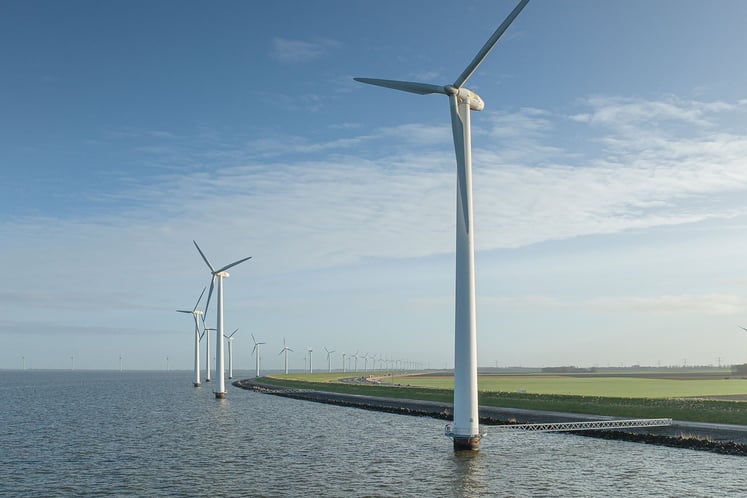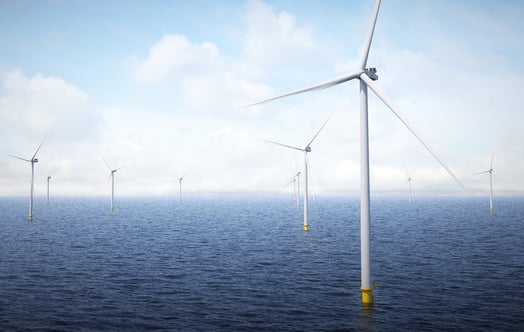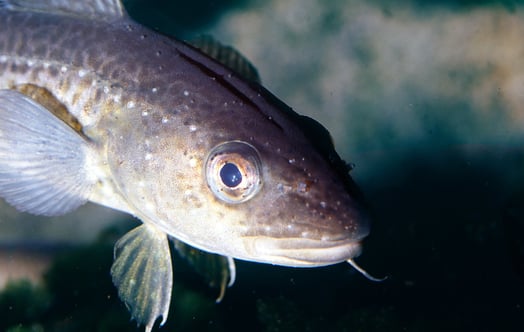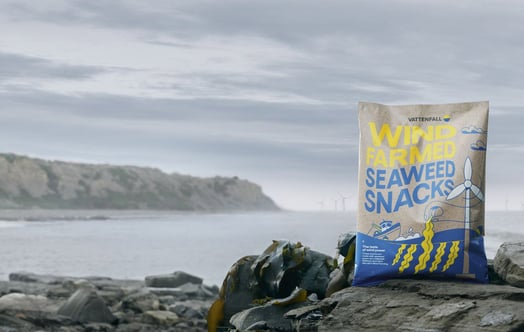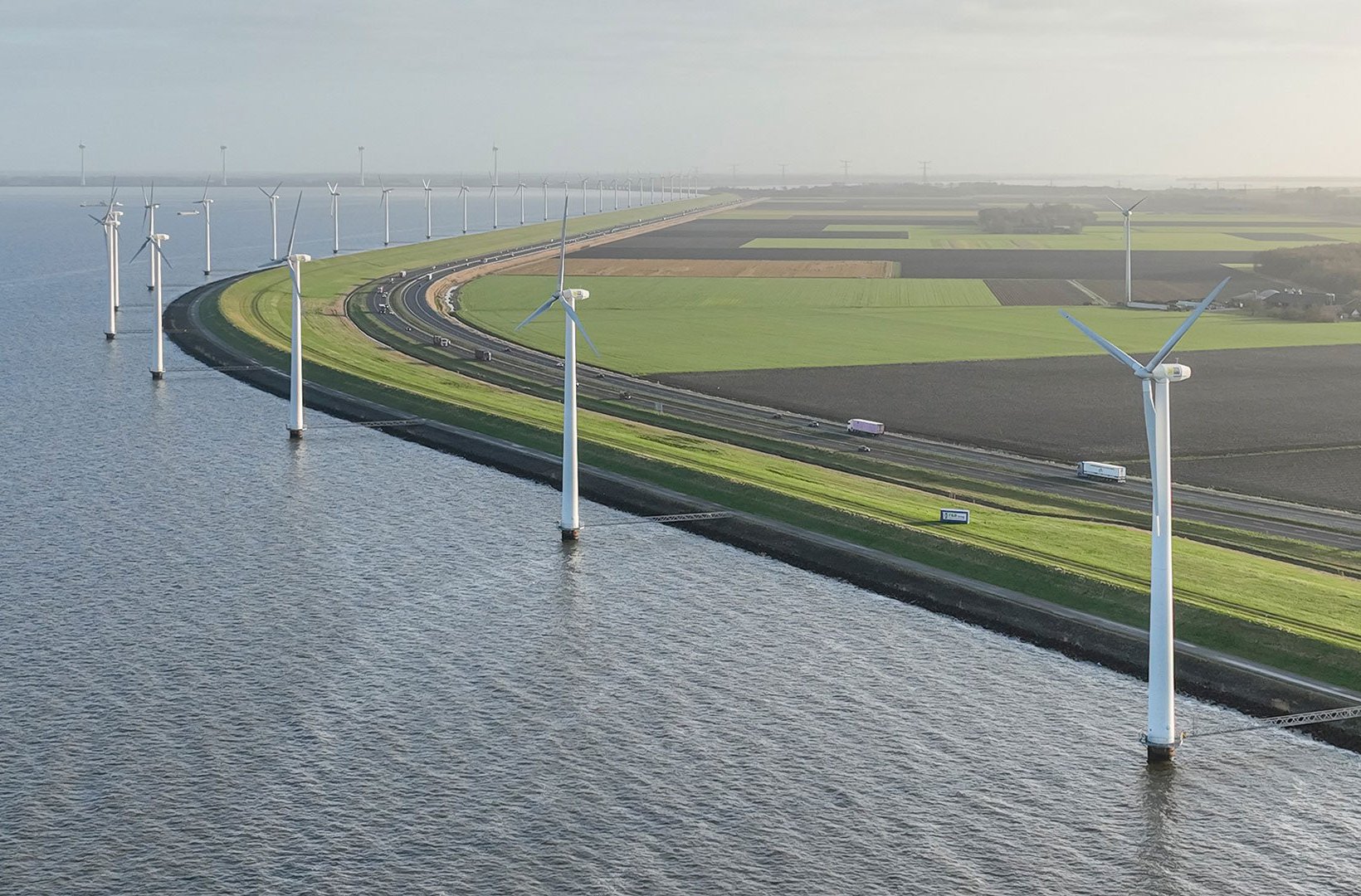
After 25 years of faithful service, the wind turbines of the Irene Vorrink Wind Farm, one of Vattenfall’s oldest wind farms in the Netherlands, will be dismantled. All parts of the wind turbines will also be recycled where possible.
The 28 wind turbines of the Irene Vorrink Wind Farm, named after the Dutch politician Irene Vorrink, who passed away in 1996, are now in the water along the IJsselmeerdijk north of Lelystad. Construction of much larger wind turbines so close to the dike is no longer permitted for reasons of dike safety. It is therefore not possible to rebuild the turbines in the same location. In place of the current 28 wind turbines with a total capacity of 16.8 MW, Vattenfall and SwifterwinT will erect two rows of 12 wind turbines with a total capacity of 132 MW, located 500 and 1500 metres further into the IJsselmeer. Of these turbines, 14 will be owned by Vattenfall and 10 by SwifterwinT.
Drawbridges
Operational Manager Herre van der Meulen has worked for Vattenfall and its predecessors for 45 years. He was involved in the construction of the wind farm in 1997 and later became the Maintenance Manager. "The wind turbines built at the end of last century have a shorter service life than the current generation of wind turbines. Developments in this area are moving at a rapid pace", he says. "But these wind turbines have worked fantastically for all these years without many problems. We only had to overhaul all the gearboxes once."
One of the things he likes about the construction of these wind turbines is the drawbridges that are only attached to the turbines and connect them to the dike. "On two occasions some of the bridges were lifted by creeping ice, but because they are only hinged on one end, there was no damage to the bridge, the dike or the wind turbine. A fine example of anticipating potential problems."
Classic example
Like Herre, Senior Development Manager Henk Kouwenhoven has worked in the wind industry for more than forty years. At the end of the 1990s, he was involved in the construction of the Irene Vorrink Wind Farm and, last year, was involved as project manager in making the investment decision for the new wind farm. In terms of landscape, the current wind farm was a classic example of how a wind farm can be integrated into the surroundings, according to Henk. But he also sees that since the start of the wind industry, the aim has been to constantly reduce the cost of electricity from wind. "The number of turbines in a wind farm is not necessarily crucial; what matters more is the efficiency of the turbines. The main gain comes from the diameter and height of the turbines, because the higher you go, the more wind there is." In addition to the aspect of dike safety, this is one of the reasons why the new wind turbines, with a tip height of around 200 metres, are more than half a kilometre offshore.
Dismantling process
The dismantling of the wind turbines and the construction of the new wind farm will be supervised by Matthew Adam May, who works in Vattenfall’s Construction Management. "Starting in early March, we will work on one wind turbine every day to prepare it for easy dismantling as much as possible. We first shut down the turbine and then remove as many bolts and electric cables as possible. All the turbines will be shut down by April, and then we will dismantle the various parts of the turbine from a barge on the water. That will be one per day if the weather cooperates", says Matthew. Once the rotor with the turbine blades, the nacelle and the tower have been removed, the bridge to the dike will also be dismantled. Eventually, there will only be a small part of the steel foundation (monopile) protruding above the water. Using special equipment, the monopile will be sawn from the inside two metres below the bottom of the IJsselmeer, and after this part is pulled out of the water the rest of the monopile and the cabling will remain in the bottom of the IJsselmeer next to the dike.
Safety
Was it not possible to remove the rest of the monopile and the cables under the dike? This was what the government bodies initially had in mind. Matthew explains the decision: “We would prefer to remove all parts of the wind turbines and leave the area in its original state, but this time the safety of the dike takes precedence." Special vibration equipment is needed to remove the foundations, and Rijkswaterstaat and the Zuiderzeeland Water Board are afraid that the vibrations could cause damage to the dike. Also, the holes left after the foundations and cables are removed could lead to seepage, with water running underneath the dike and weakening it.
Recycling
The turbines from the Irene Vorrink Wind Farm are too small and too old to be reused at another location, so all parts of the turbines will be recycled where possible. “Many materials from the tower to the nacelle are relatively easy to recycle", says Matthew, “because they consist of steel, copper and other metals, as well as oils and plastics.” Recycling the turbine blades is a tricky process, but Vattenfall has committed to recycling them fully by 2030. Matthew says that he already expects to be able to achieve this goal with the 84 dismantled turbine blades. “We are in discussion with a few parties to have all the blades recycled into high-quality raw materials for completely new products.”
Video player requires marketing cookies.
To view this content please click here to allow marketing cookies.
Wind farm Irene Vorrink
Project Windplanblauw
The 24 new wind turbines in the IJsselmeer are part of the Windplanblauw project, which is being jointly developed by Vattenfall and the SwifterwinT wind cooperative in the north-western corner of the Province of Flevoland.
The existing 74 onshore and offshore wind turbines will be replaced by 61 larger turbines with more power.
Windplanblauw is expected to be operational from 2023.
Photo and video:
Jorrit Lousberg

